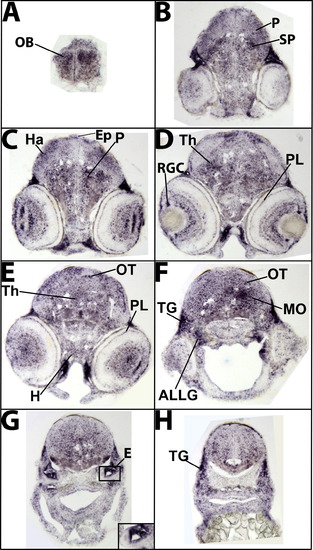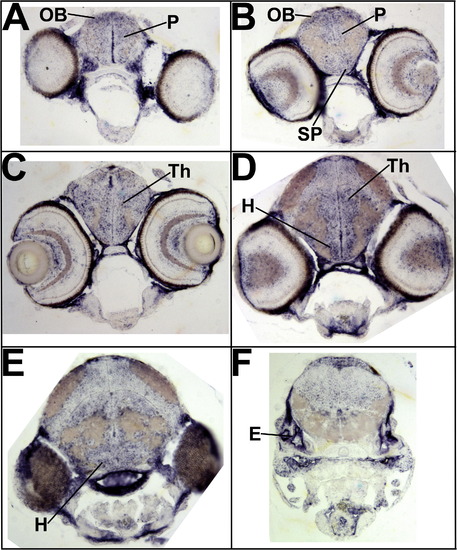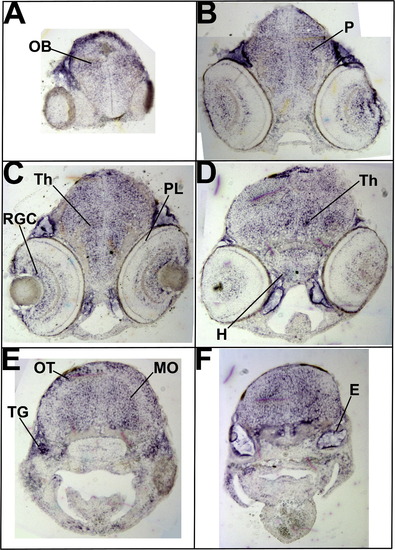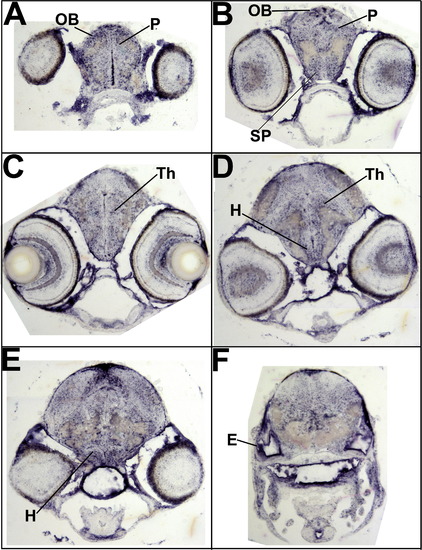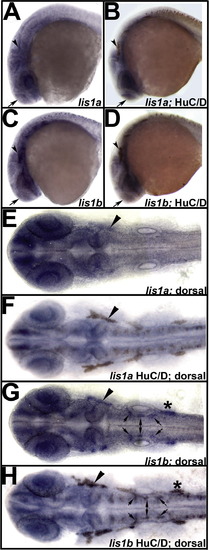- Title
-
Characterization of the overlapping expression patterns of the zebrafish LIS1 orthologs
- Authors
- Drerup, C.M., Wiora, H.M., and Morris, J.A.
- Source
- Full text @ Gene Expr. Patterns
|
LIS1 is highly conserved across species and is expressed in the developing zebrafish. (A) The LIS1 protein is highly conserved between vertebrate and invertebrate species. Two orthologs of LIS1 exist in the zebrafish, likely due to a whole genome duplication event. There is a 93% conservation of amino acid sequence between these two proteins and conservation between species is similar for each. Percent conserved amino acid identity between the listed species and zebrafish Lis1 orthologs are shown respectively in parentheses (Lis1a and Lis1b respectively). (B) Semi-quantitative RT-PCR analysis of lis1a expression in the developing zebrafish illustrates maternal expression of this transcript at 1hr. Expression levels decrease after 8 hpf and then reach a fairly steady-state level through early larval development. (C) Similarly, semi-quantitative RT-PCR analysis of lis1b demonstrates maternal expression of this transcript with a decline in expression after 8 hpf. However, unlike lis1a, lis1b expression increases from 24 hpf to 72 hpf, in the early stages of larval development. A portion of β-actin was amplified in a multiplexed PCR reaction for both transcripts to serve as an internal control. In addition, a no RT (reverse transcriptase) control (last lane) was done for each using 24 hpf total RNA. EXPRESSION / LABELING:
|
|
lis1a is expressed in the peripheral and central nervous system of the developing zebrafish. (A and B) In situ hybridization with a lis1a specific probe illustrates a lack of expression in the zebrafish embryo at 14 hpf and 16 hpf. (C and G) At 24 hpf, there is expression of this transcript in the forebrain, midbrain and hindbrain. In addition, there is light expression in the trigeminal ganglion, a part of the peripheral nervous system (G, arrowhead). (D–F,H–J) Expression of lis1a continues in the developing zebrafish brain and peripheral nervous system into larval stages, 72 hpf through 120 hpf, when the larvae have begun to freely swim and feed. MHB-midbrain–hindbrain boundary. Arrowheads (G–J) indicate the trigeminal ganglion. C–F views are lateral with anterior to the left. A,B,G–J views are dorsal with anterior to the left. There is nonspecific probe trapping in the pharynx and swimbladder. EXPRESSION / LABELING:
|
|
lis1a expression in the larval zebrafish brain at 72 hpf. (A–C) Coronal sections of a 72 hpf larval zebrafish after lis1a specific in situ hybridization demonstrate expression in the developing olfactory bulb, pallium, subpallium, epiphysis and habenula. (D and E) In the diencephalon and mesencephalon, lis1a is expressed in the thalamus, hypothalamus and optic tectum. As has been noted previously, lis1a is highly expressed in the retinal ganglion cell layer and is also expressed in the photoreceptor cell layer of the 72 hpf zebrafish eye. (E–H) In the most caudal sections presented, lis1a is prominently expressed in the hindbrain. In addition, lis1a is highly expressed in the ear (G) and trigeminal ganglion (F–H). Inset (G) is higher magnification of the area indicated by the box. Abbreviations used: OB, olfactory bulb; P, pallium; SP, subpallium; Ep, epiphysis (pineal); Ha, habenula; Th, thalamus; RGC, retinal ganglion cell layer; PL, photoreceptor cell layer; H, hypothalamus; OT, optic tectum; TG, trigeminal ganglion; ALLG, anterior lateral line ganglion; MO, medulla oblongata; E, ear. EXPRESSION / LABELING:
|
|
lis1a expression in the larval zebrafish brain at 120 hpf. In situ hybridization was performed on a 120 hpf larval zebrafish with a lis1a specific probe. (A and B) Coronal sections demonstrate prominent lis1a expression in the olfactory bulb as well as the pallium and subpallium. (C–E) At 120 hpf, there is continued expression of lis1a in the thalamus and hypothalamus. (F) The most caudal section presented shows continued expression of lis1a in the ventral hindbrain as well as prominent expression in the ear. Abbreviations used: OB, olfactory bulb; P, pallium; SP, subpallium; Th, thalamus; H, hypothalamus; E, ear. EXPRESSION / LABELING:
|
|
lis1b is expressed in the peripheral and central nervous system of the developing zebrafish. (A and B) Dorsal views show that, similar to lis1a, lis1b is not expressed at 14 hpf or 16 hpf. (C) By 24 hpf, a lateral view demonstrates noticeable lis1b expression in the developing brain, cranial ganglia (arrowhead) and Rohon-beard neurons along the dorsal aspect of the embryo (arrow). In addition, lis1b is expressed at the midbrain–hindbrain boundary. (G) A dorsal view at 24 hpf indicates lis1b is expressed in the developing forebrain (arrow) and trigeminal ganglion (arrowhead). Additionally, the dorsal view shows strong lis1b expression in other cranial ganglia (*) and punctate groups of neurons in the developing hindbrain (small arrows). (D–F,H–J) Expression of lis1b in the central and peripheral nervous system continues through larval development. Arrowheads (G–J) indicate the trigeminal ganglion. MHB-midbrain–hindbrain boundary. C–F views are lateral with anterior to the left. A,B,G–J views are dorsal with anterior to the left. There is nonspecific probe trapping in the pharynx, swimbladder and somites (F). EXPRESSION / LABELING:
|
|
lis1b expression in the larval zebrafish brain at 72 hpf. In situ hybridization with a lis1b specific riboprobe demonstrates almost ubiquitous expression throughout the developing zebrafish brain. (A and B) Similar to lis1a, lis1b is expressed in the olfactory bulb, pallium, and subpallium. (C and D) High expression of lis1b is also detectable in the diencephalon. In the 72 hpf zebrafish eye (C), lis1b is expressed in the retinal ganglion cell layer and photoreceptor cell layer. (E and F) Hindbrain expression of lis1b includes the optic tectum and medulla oblongata. In addition, similar to lis1a, lis1b is expressed in the trigeminal ganglion and ear. Abbreviations used: OB, olfactory bulb; P, pallium; Th, thalamus; RGC, retinal ganglion cell layer; PL, photoreceptor cell layer; H, hypothalamus; TG, trigeminal ganglion; OT, optic tectum; MO, medulla oblongata; E, ear. EXPRESSION / LABELING:
|
|
lis1b expression in the larval zebrafish brain at 120 hpf. In situ hybridization was performed on a 120 hpf larval zebrafish with a lis1b specific probe. (A and B) Coronal sections demonstrate prominent lis1b expression in the olfactory bulb similar to lis1a. Lis1b is also expressed in the pallium. (C–E) At 120 hpf, there is continued expression of lis1b in the thalamus and hypothalamus. (F) The most caudal section presented shows continued expression of lis1b in the ventral hindbrain as well as prominent expression in the ear. Abbreviations used: OB, olfactory bulb; P, pallium; SP, subpallium; Th, thalamus; H, hypothalamus; E, ear. EXPRESSION / LABELING:
|
|
Immunohistochemical double labeling confirms expression of the LIS1 orthologs in the neurons of the developing central and peripheral neural structures. (A) lis1a expression at 24 hpf is localized to the zebrafish peripheral and central nervous system including the trigeminal ganglion (arrowhead) and forebrain (arrow). (B) This tissue was confirmed as neural by double labeling with an antibody specific for newly matured neurons (HuC/D). (C and D) Similarly, expression of lis1b in the peripheral (arrowhead) and central (arrow) nervous system was confirmed with double labeling for HuC/D. These views are lateral with anterior to the left. (E–H) Dorsal views of 24 hpf embryos further confirm the double labeling of structures for these two orthologs. (E,F) lis1a is expressed highly in the developing forebrain and trigeminal ganglion (arrowhead) at this stage. (G and H) Similarly, lis1b is expressed in the developing forebrain and trigeminal ganglion (arrowhead). Additionally, these dorsal views show strong lis1b expression in other cranial ganglia (*) and punctate groups of neurons in the developing hindbrain (small arrows). These additional areas of expression and the previously described expression in Rohon-Beard sensory neurons are unique for this ortholog. EXPRESSION / LABELING:
|
Reprinted from Gene expression patterns : GEP, 10(1), Drerup, C.M., Wiora, H.M., and Morris, J.A., Characterization of the overlapping expression patterns of the zebrafish LIS1 orthologs, 75-85, Copyright (2010) with permission from Elsevier. Full text @ Gene Expr. Patterns



